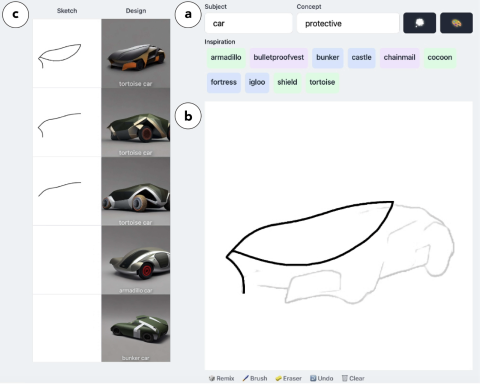Inkspire
Supporting Design Exploration with Generative AI through Analogical Sketching
2024

The Inkspire interface. The designer may use the Analogical Panel (a) to ideate analogical inspirations for abstract concepts (e.g., “protective car” → “tortoise car”). The designer may sketch on the Sketching Panel (b) to iteratively guide AI design generations. For each iteration, we display a sketch scaffolding under the canvas. This scaffolding is created through abstracting AI designs into lower fidelity. Finally, the designer may view the history of iterations on the Evolution Panel (c).
With recent advancements in the capabilities of Text-to-Image (T2I) AI models, product designers have begun experimenting with them in their work. However, T2I models struggle to interpret abstract language and the current user experience of T2I tools can induce design fixation rather than a more iterative, exploratory process. To address these challenges, we developed Inkspire, a sketch-driven tool that supports designers in prototyping product design concepts with analogical inspirations and a complete sketch-to-design-to-sketch feedback loop. To inform the design of Inkspire, we conducted an exchange session with designers and distilled design goals for improving T2I interactions. In a within-subjects study comparing Inkspire to ControlNet, we found that Inkspire supported designers with more inspiration and exploration of design ideas, and improved aspects of the co-creative process by allowing designers to effectively grasp the current state of the AI to guide it towards novel design intentions.
Details: Inkspire (pdf)
Researchers
David Chuan-en Lin, Hyeonsu Kang, Nikolas Martelaro, Aniket (Niki) Kittur ,
Yan-Ying Chen, Matthew K. Hong (Toyota Research Institute)
Research Areas

